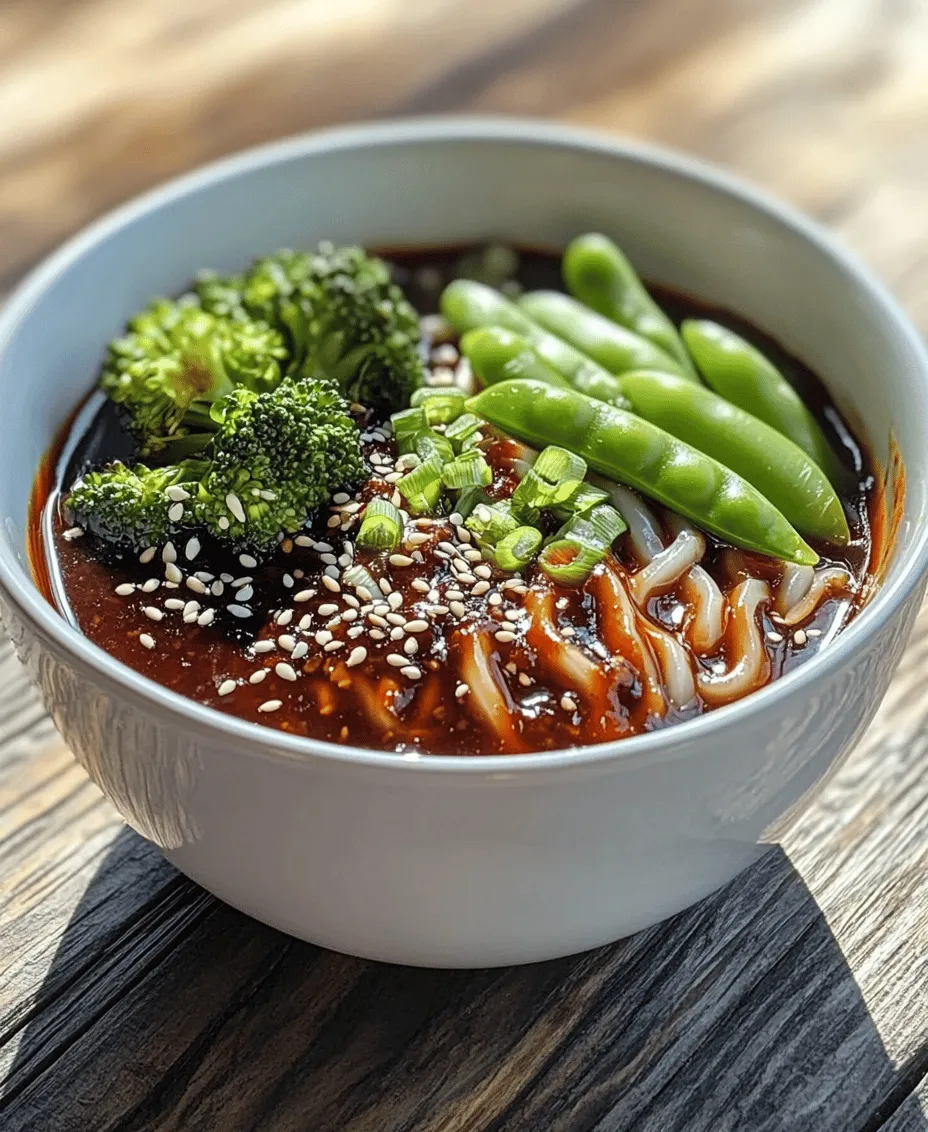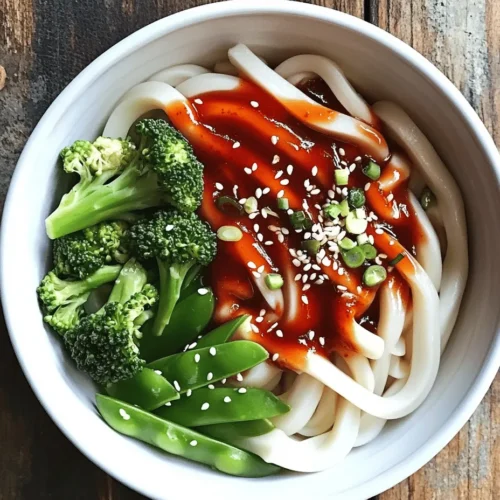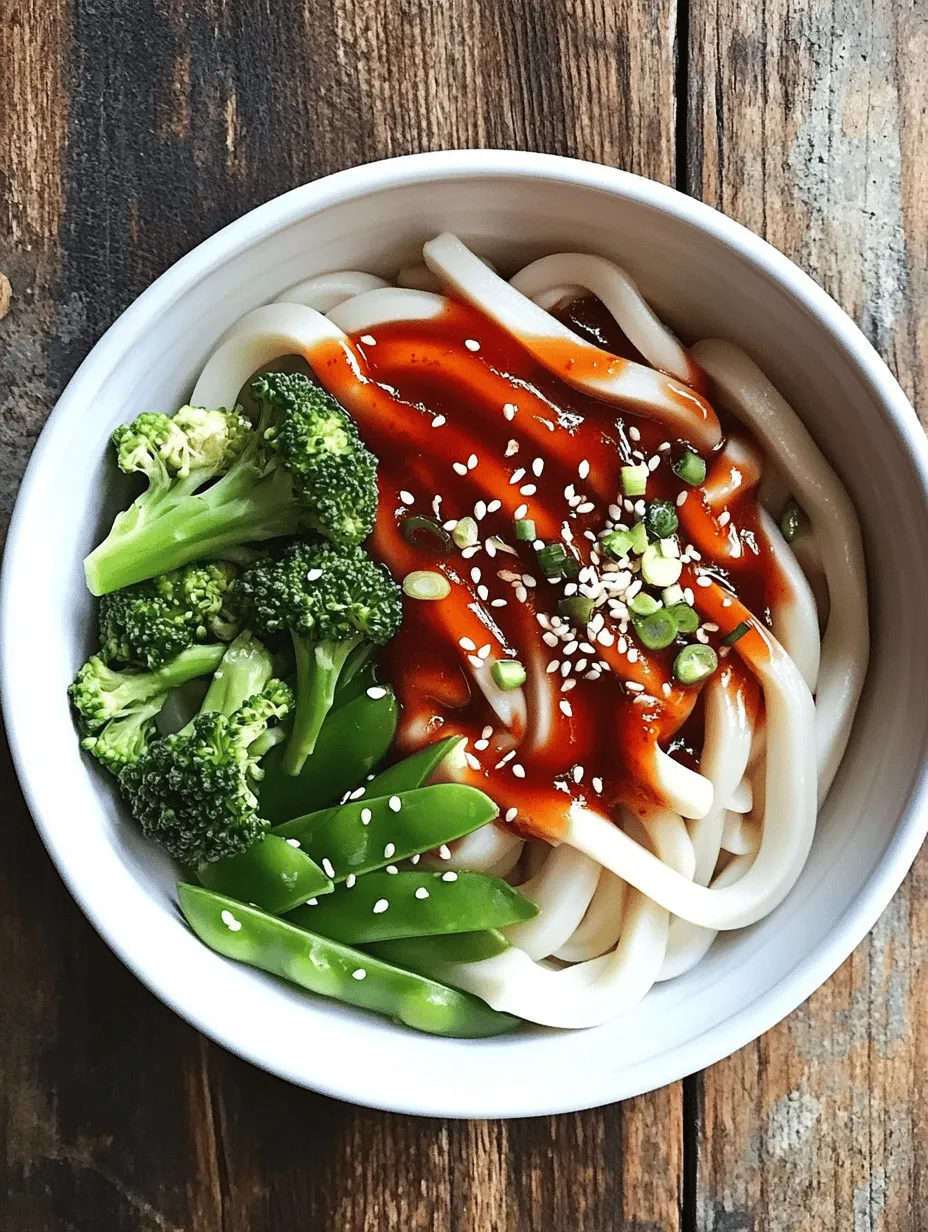Introduction
Udon noodles, a beloved staple in Asian cuisine, have captured the hearts (and stomachs) of food enthusiasts around the world. Known for their thick, chewy texture and versatility, these Japanese noodles serve as the perfect canvas for a multitude of flavors, making them a popular choice in both home-cooked meals and gourmet dining. Among the many delicious ways to prepare udon, one standout dish is Quick and Zesty Chili Oil Udon Noodles.
This recipe is not only quick to prepare but also bursting with vibrant flavors that dance on your palate. Combining the rich, savory taste of udon noodles with the zesty kick of chili oil, this dish is ideal for those who appreciate a balance of heat and umami. Whether you’re in a rush after a long day or looking for a satisfying meal that won’t take hours to prepare, these udon noodles offer a perfect solution.
What makes this dish particularly appealing is its adaptability. You can easily customize it by adding your favorite vegetables, proteins, or even switching up the spices to suit your taste preferences. With just a few simple ingredients and steps, you’ll be diving into a bowl of deliciousness that showcases the beautiful harmony of flavors that udon noodles can deliver.
Understanding Udon Noodles
Udon noodles are a type of thick wheat noodle that originated in Japan. They are renowned for their smooth and chewy texture, which provides a delightful bite that is both satisfying and nourishing. Typically served in a hot broth or stir-fried, udon can easily absorb flavors from sauces and toppings, making them an excellent choice for a variety of dishes.
One of the standout features of udon is its nutritional profile. Udon noodles are primarily made from wheat flour, water, and salt, which means they are rich in carbohydrates, providing a good source of energy. Moreover, they are relatively low in fat and can be a good source of protein, especially when paired with protein-rich ingredients like tofu, chicken, or shrimp. For those looking to include more fiber in their diet, consider opting for whole-grain udon noodles, which offer added nutritional benefits.
When compared to other popular noodles such as ramen and soba, udon stands out due to its thickness and texture. Ramen noodles are typically thinner and curlier, often found in a rich broth, while soba noodles, made from buckwheat, have a distinct nutty flavor and are usually served either hot or cold. Each noodle type has its unique culinary uses, but udon remains a favorite for its versatility and satisfying chew.
The Appeal of Chili Oil
Chili oil, a staple in many Asian households, brings a fiery kick to dishes and is a key ingredient in our Quick and Zesty Chili Oil Udon Noodles. Originating from China, chili oil is made by infusing oil with dried chili peppers, garlic, and other spices. This aromatic oil not only adds heat but also enhances the overall flavor profile of a dish. Its popularity has spread across various cuisines, making it a common condiment on tables worldwide.
In addition to its delectable taste, chili oil offers several health benefits. Various studies suggest that capsaicin, the compound responsible for the heat in chili peppers, may boost metabolism and aid in weight loss. Furthermore, chili oil can enhance circulation and contribute to overall digestive health. For those who enjoy the thrill of spice, chili oil is an excellent way to elevate your dishes while providing potential health benefits.
One of the beauties of using chili oil in cooking is its versatility in heat levels. You can easily adjust the amount of chili oil used in your udon noodles to suit your personal preference. Whether you prefer a mild warmth or a fiery blaze, the choice is yours. For those who want to experiment, creating your homemade chili oil allows you to control the ingredients and spice levels, ultimately tailoring it to your taste.
Ingredient Breakdown
To create the Quick and Zesty Chili Oil Udon Noodles, you’ll need a selection of simple yet impactful ingredients. Here’s a detailed breakdown of each component:
– Fresh Udon Noodles: Using fresh udon noodles is crucial for achieving the best texture and flavor. Fresh noodles have a soft, chewy quality that dried noodles simply can’t replicate. They cook quickly and easily absorb the flavors of the sauce, offering a satisfying experience with every bite. You can typically find fresh udon noodles in the refrigerated section of your local grocery store or Asian market, making them a convenient choice.
– Chili Oil: As mentioned earlier, chili oil is the star of this dish. You can either purchase pre-made chili oil from Asian grocery stores or make your own at home by infusing oil with dried chilies, garlic, and spices. Homemade chili oil allows you to customize the heat levels and flavors to your liking, enhancing the overall dish.
– Soy Sauce: Soy sauce is a key ingredient in many Asian dishes, and it plays a significant role in seasoning the udon noodles. There are various types of soy sauce available, including light soy sauce, dark soy sauce, and tamari (gluten-free). Light soy sauce is typically saltier and is suitable for seasoning, while dark soy sauce is thicker and adds a rich color and depth of flavor. Experimenting with different types of soy sauce can significantly impact the taste of your udon noodles.
– Rice Vinegar: Rice vinegar adds a tangy flavor that balances the richness of the chili oil and soy sauce. It brightens the dish and enhances the overall flavor profile. If you don’t have rice vinegar on hand, apple cider vinegar can serve as a suitable substitute, though the flavor may vary slightly.
– Sesame Oil: Adding sesame oil introduces a nutty depth and richness to the dish. It complements the heat of the chili oil while adding a layer of sophistication to the flavor. A little goes a long way, so be cautious not to overdo it.
– Garlic and Ginger: These aromatic ingredients are essential for enhancing the overall taste of the udon noodles. Fresh garlic adds a pungent kick, while ginger contributes a warm, zesty note. Together, they create a fragrant base that elevates the dish.
– Spring Onion: Used as a garnish, spring onions not only add a pop of color but also provide a fresh crunch that contrasts beautifully with the chewy udon noodles. They enhance the dish’s flavor and bring a refreshing element to every bite.
– Optional Vegetables: For those looking to add more nutrition and color to the dish, consider incorporating optional vegetables like broccoli or snap peas. These vegetables not only elevate the dish visually but also add texture and nutrients, making the meal more balanced and satisfying.
Incorporating these ingredients into your Quick and Zesty Chili Oil Udon Noodles will ensure a delicious, flavorful experience that showcases the best of Asian cuisine. The next part of this article will guide you through the step-by-step process of preparing this delectable dish, ensuring that you can enjoy it at home in no time.

Garnishes: Sesame Seeds and Cilantro for Flavor and Presentation
No dish is complete without the perfect finishing touches, and for your Quick and Zesty Chili Oil Udon Noodles, sesame seeds and fresh cilantro are essential. The nutty flavor of toasted sesame seeds adds a delightful crunch, while cilantro introduces a burst of freshness, perfectly balancing the rich, zesty sauce. As you plate your noodles, sprinkle a generous amount of sesame seeds and top with a handful of chopped cilantro. This not only enhances the flavor profile but also elevates the visual appeal of your dish, making it as inviting to the eyes as it is to the palate.
Step-by-Step Cooking Instructions
Cooking the Udon Noodles: Importance of Timing
1. Boil the Water: Begin by filling a large pot with water and bringing it to a rolling boil. It’s crucial to use plenty of water to prevent the noodles from sticking together as they cook.
2. Add the Udon Noodles: Carefully add your udon noodles to the boiling water. Fresh udon typically cooks in about 2-3 minutes, while dried udon may require 6-8 minutes. Check the package instructions for precise timing.
3. Stir Occasionally: Gently stir the noodles occasionally to ensure they cook evenly and don’t clump together.
4. Taste Test: Once the cooking time is approaching, taste a noodle to check for doneness. Udon should be tender but still have a slight bite (al dente).
5. Drain and Rinse: Once cooked, drain the noodles in a colander and rinse them briefly under cold water to stop the cooking process and remove excess starch. This step is especially important if you plan to serve the noodles later.
Preparing the Sauce: Achieving the Perfect Balance of Flavors
1. Combine Ingredients: In a mixing bowl, combine soy sauce, chili oil, rice vinegar, and a touch of sugar. Adjust the quantities according to your taste preferences; you may prefer more heat or sweetness.
2. Mix Thoroughly: Whisk the ingredients together until the sugar is fully dissolved and the mixture is well combined. The goal is to achieve a harmonious balance of savory, spicy, and slightly sweet flavors.
3. Taste and Adjust: Taste the sauce and adjust the flavors if necessary. If you like it spicier, add more chili oil. For more acidity, a splash of additional rice vinegar will do the trick.
Combining the Noodles and Sauce: Methods for Even Coating
1. Heat a Pan: In a large skillet or wok, heat a small amount of oil over medium heat. This step is optional but helps to enhance the flavors as you combine the noodles and sauce.
2. Add the Noodles: Once the oil is hot, add the drained udon noodles to the pan. Allow them to heat through for a minute or two.
3. Pour the Sauce: Pour your prepared sauce over the warm noodles.
4. Toss to Combine: Using tongs or chopsticks, gently toss the noodles with the sauce to ensure an even coating. Be careful not to break the noodles; the goal is to keep them intact while ensuring each strand is enveloped in the zesty sauce.
5. Heat Through: Continue to toss the noodles in the pan for another couple of minutes, allowing the flavors to meld and the noodles to absorb the sauce.
Garnishing for Presentation: Tips for an Appetizing Look
1. Plate the Noodles: Use tongs to twirl a portion of the noodles onto each serving plate, creating a nest-like presentation.
2. Sprinkle Sesame Seeds: Generously sprinkle toasted sesame seeds over the top of the noodles.
3. Add Cilantro: Finish by scattering freshly chopped cilantro on top. For an extra touch, consider adding thinly sliced green onions or chili flakes for added color and flavor.
Serving Suggestions
Your Quick and Zesty Chili Oil Udon Noodles can stand alone as a delightful main dish, but they can also be enhanced with various proteins and side dishes for a more substantial meal.
Pairing with Proteins
– Chicken: Grilled or stir-fried chicken breast, marinated in a little soy sauce and sesame oil, pairs wonderfully with the noodles.
– Tofu: For a vegetarian or vegan option, sauté firm tofu until golden brown and serve it over the noodles for added protein and texture.
– Shrimp: Lightly seasoned and sautéed shrimp can elevate the dish, adding a savory touch that complements the zesty flavors.
Suggestions for Side Dishes
– Asian-Style Salads: A refreshing cucumber salad or a simple mixed greens salad dressed with sesame vinaigrette can provide a crisp contrast to the rich noodles.
– Steamed Dumplings: Complement your udon noodles with steamed dumplings filled with pork, vegetables, or shrimp for a delightful pairing that offers different textures and flavors.
Recommendations for Beverages
– Green Tea: A warm cup of green tea is a classic companion to any Asian meal, enhancing the flavors of the dish without overpowering it.
– Sake: If you enjoy alcoholic beverages, consider pairing your meal with a light sake that complements the umami flavors of the noodles.
Variations and Customizations
One of the best aspects of Quick and Zesty Chili Oil Udon Noodles is their versatility. You can easily customize the dish to suit various dietary preferences or seasonal ingredients.
Exploring Dietary Options
– Vegetarian/Vegan: Simply replace chicken or shrimp with tofu or a medley of your favorite vegetables. Ensure that the soy sauce is vegan (most are, but it’s good to check).
– Gluten-Free: For a gluten-free option, swap traditional udon noodles for rice noodles or gluten-free udon varieties available in most grocery stores.
Suggested Ingredient Substitutions
– Vegetables: Feel free to customize your dish with seasonal vegetables. Bell peppers, broccoli, or snap peas add color and nutrition. Sauté them briefly before adding the noodles for a fresh crunch.
– Spiciness: Adjust the level of heat by varying the amount of chili oil or incorporating fresh sliced chilies if you prefer a more intense flavor.
Nutritional Information
Understanding the nutritional content of your meal is essential for maintaining a balanced diet. Here’s a breakdown of the main components of your Quick and Zesty Chili Oil Udon Noodles.
Overview of the Dish’s Nutritional Content
This dish is relatively low in calories, especially if you focus on portion control and the types of proteins you add. The base of udon noodles provides carbohydrates for energy, while the addition of vegetables and proteins contributes essential vitamins, minerals, and proteins.
Health Benefits of Key Ingredients
– Udon Noodles: A good source of carbohydrates, providing energy for the body. They can also be a source of iron, depending on the brand.
– Chili Oil: Contains capsaicin, which may boost metabolism and has anti-inflammatory properties.
– Cilantro: Rich in antioxidants and may aid in digestion; it also adds a fresh burst of flavor without adding calories.
Balancing the Dish Within a Healthy Diet
Incorporating Quick and Zesty Chili Oil Udon Noodles into a balanced diet can be simple. Pair these noodles with plenty of vegetables and a lean protein source to create a well-rounded meal. As with any dish, moderation is key, and being mindful of portion sizes can help maintain overall health.
Conclusion
Quick and Zesty Chili Oil Udon Noodles offer a perfect blend of simplicity and flavor, making them an ideal meal for busy weeknights or a satisfying lunch. This recipe encourages creativity in the kitchen—experiment with different garnishes, proteins, and vegetables to make it your own.
Cooking is not just about sustenance; it’s an opportunity to express yourself and enjoy the process. The joy of creating a delicious homemade dish like this one is something to cherish. So, gather your ingredients, follow the steps, and savor the delight of your culinary creation. Enjoy your cooking journey and the flavorful results that follow!



